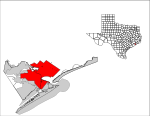Texas City Prairie Preserve
The Texas City Prairie Preserve is a 2,300-acre (9.3 km2) nature preserve located on the shores of Moses Lake and Galveston Bay in Texas City, Texas in the United States, near Houston. The preserve was created in 1995 by the Nature Conservancy thanks to a $2.2 million donation of land by ExxonMobil. The primary goal in creating the preserve was to save the endangered Attwater's prairie chicken, though the preserve protects coastal prairie and supports a wide variety of wildlife.The terrain of the preserve includes prairie and wetland habitats, enabled in large part by restoration efforts in recent decades. The preserve includes 40 acres (0.16 km2) of limited public access areas including a small hiking trail. The remainder of the preserve is closed but available for tours and access at the discretion of preserve staff, including birding events and volunteer events.The preserve is part of the Great Texas Coastal Birding Trail, a network of preserves and trails along the Texas coast featuring habitats for birds and other wildlife.
Excerpt from the Wikipedia article Texas City Prairie Preserve (License: CC BY-SA 3.0, Authors).Texas City Prairie Preserve
Geographical coordinates (GPS) Address Nearby Places Show on map
Geographical coordinates (GPS)
| Latitude | Longitude |
|---|---|
| N 29.45 ° | E -94.95 ° |
Address
77395
Texas, United States
Open on Google Maps







